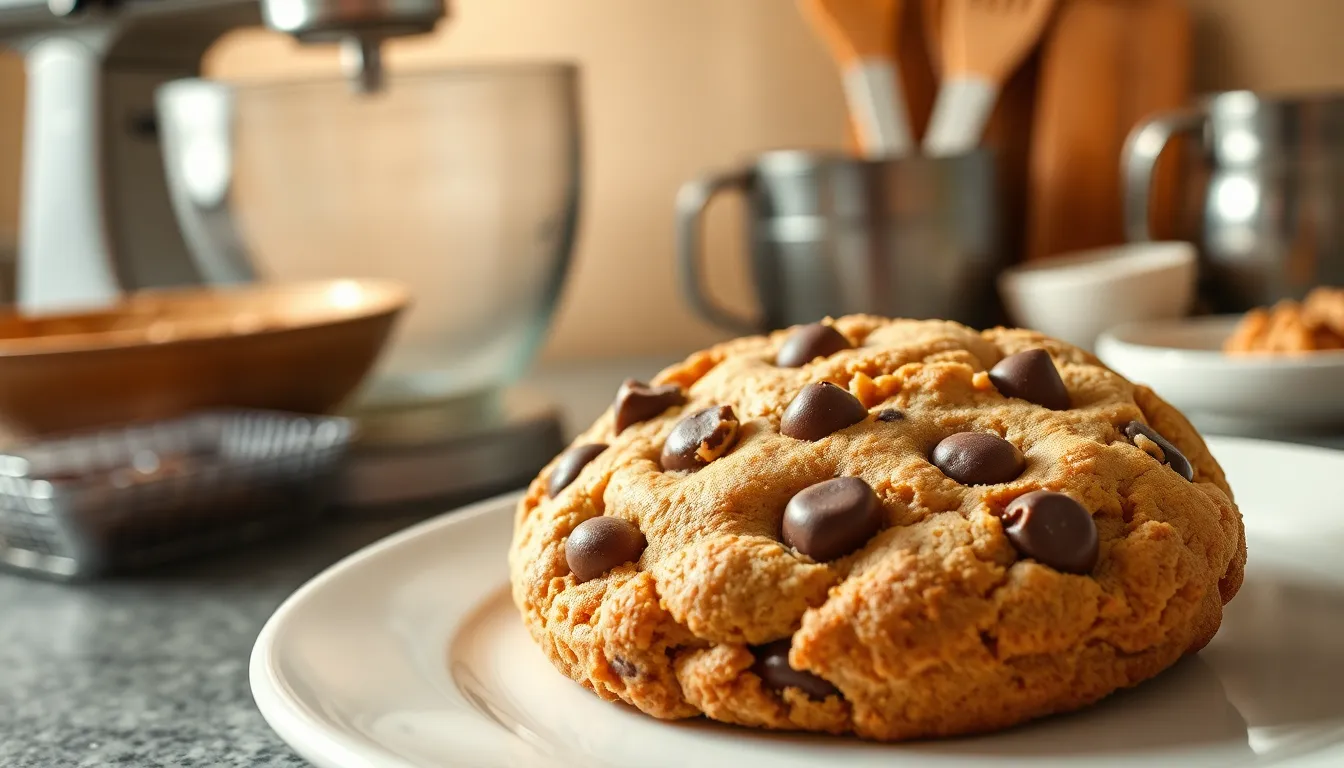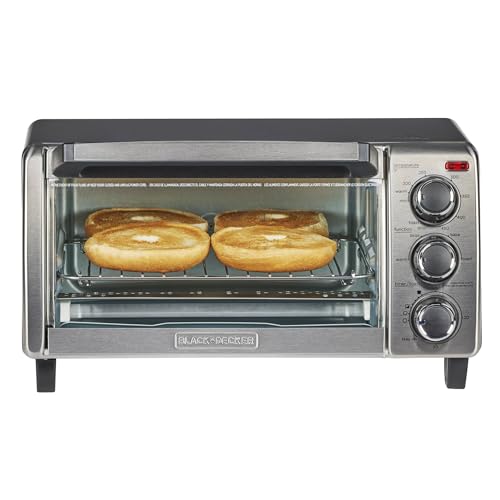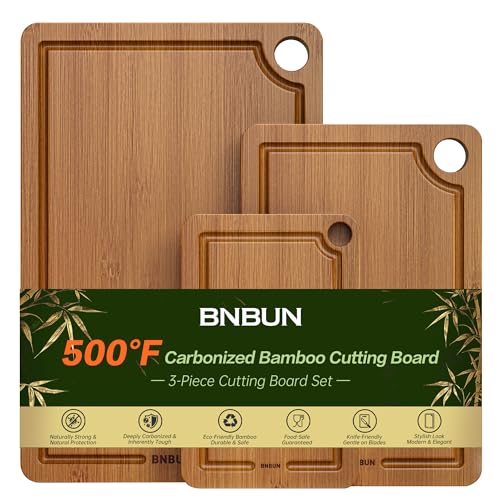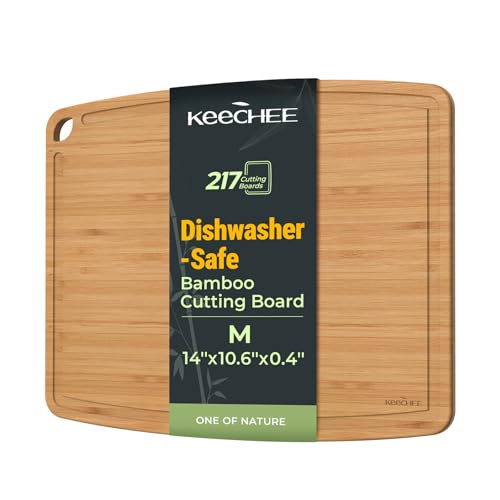What Makes DoubleTree Cookies Special
DoubleTree cookies stand apart from ordinary chocolate chip cookies through their distinctive warm hospitality presentation. You receive these freshly baked treats at check-in, creating an immediate sense of welcome that transforms your hotel experience from the very first moment.
The signature size sets these cookies apart from standard homemade versions. Each cookie measures approximately 3 inches in diameter and weighs nearly 2 ounces, delivering substantial satisfaction with every bite. This generous portion reflects the hotel chain’s commitment to exceeding guest expectations.
Texture perfection defines the DoubleTree cookie experience. You’ll discover the ideal balance between crispy golden edges that provide a satisfying crunch and soft chewy centers that melt on your tongue. This dual texture profile requires precise baking techniques and exact ingredient ratios.
Premium ingredients elevate these cookies beyond typical recipes. Real butter creates the rich base flavor while brown sugar adds molasses notes that enhance the overall taste complexity. The chocolate chips aren’t standard grocery store varieties – DoubleTree uses high-quality semi-sweet morsels that maintain their shape during baking.
| Cookie Specification | DoubleTree Standard |
|---|---|
| Diameter | 3 inches |
| Weight | 2 ounces |
| Baking Temperature | 300°F |
| Baking Time | 18-23 minutes |
The secret vanilla extract blend contributes to the cookies’ distinctive aroma and flavor profile. You won’t find this exact combination in standard recipes, as DoubleTree developed their formula specifically for consistency across thousands of hotel locations worldwide.
Walnut pieces add textural contrast and nutty richness that complements the chocolate without overwhelming the primary flavors. The nuts are precisely sized to distribute evenly throughout each cookie, ensuring every bite contains the perfect balance of ingredients.
Temperature control during serving maintains the cookies’ appeal. DoubleTree presents these treats while still warm, allowing the chocolate to remain slightly soft and the butter to carry maximum flavor impact. This attention to serving temperature creates the memorable first impression that guests associate with the brand.
Essential Equipment and Tools
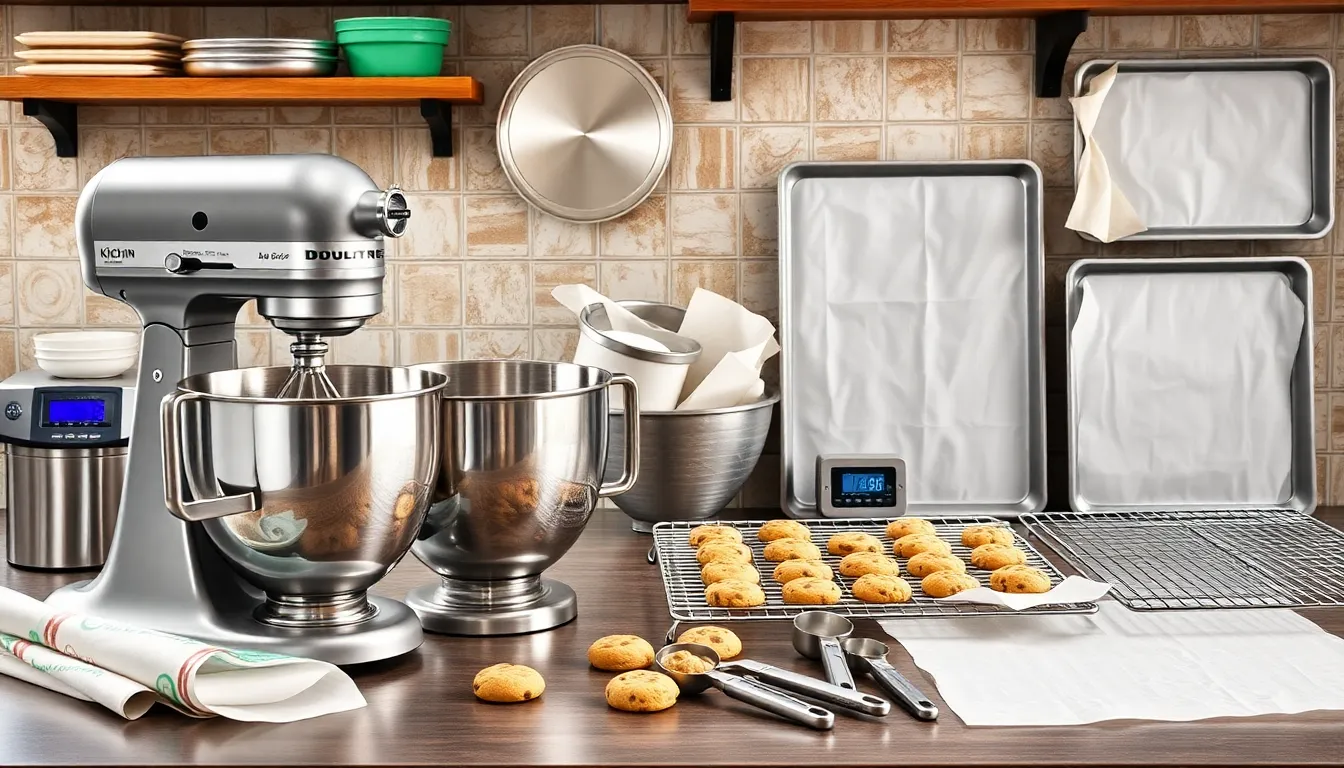
Creating authentic DoubleTree cookies requires exact equipment to achieve the signature texture and professional appearance. Your success depends on having the right tools that deliver consistent results every time you bake.
Mixing Equipment
A stand mixer with paddle attachment works best for combining ingredients thoroughly without overworking the dough. The paddle creates the perfect creaming action between butter and sugars that develops the ideal cookie structure. Hand mixers serve as suitable alternatives though they require more attention during the creaming process.
Large mixing bowls accommodate the generous cookie dough portions while providing adequate space for proper ingredient incorporation. Stainless steel or glass bowls work exceptionally well for temperature control during mixing.
Measuring Tools
Digital kitchen scales ensure precise measurements that match the original recipe specifications. DoubleTree cookies require exact ingredient ratios to achieve their distinctive taste and texture profile. Measuring cups and spoons provide backup options though scales deliver superior accuracy.
Liquid measuring cups with clear markings help you measure vanilla extract and other liquid ingredients with precision. The recipe’s success relies heavily on maintaining proper ingredient proportions.
Baking Equipment
Heavy duty sheet pans distribute heat evenly across cookie surfaces creating uniform golden edges. Light colored pans prevent excessive browning while promoting even baking throughout each cookie. You need at least two sheet pans to maintain efficient baking rotation.
Parchment paper eliminates sticking issues while creating easy release surfaces for your finished cookies. Silicone baking mats offer reusable alternatives that provide consistent non stick performance.
Cookie scoops in 2 ounce portions help you create uniformly sized cookies that match DoubleTree standards. These tools ensure each cookie weighs approximately 2 ounces for authentic presentation.
Temperature Control Tools
An oven thermometer verifies accurate baking temperatures since many home ovens run hot or cold. DoubleTree cookies require precise 350°F temperatures to develop their characteristic crispy edges and chewy centers.
Cooling racks allow proper air circulation around freshly baked cookies preventing soggy bottoms while maintaining optimal texture. Wire racks with tight spacing work best for supporting large cookies without sagging.
Ingredients
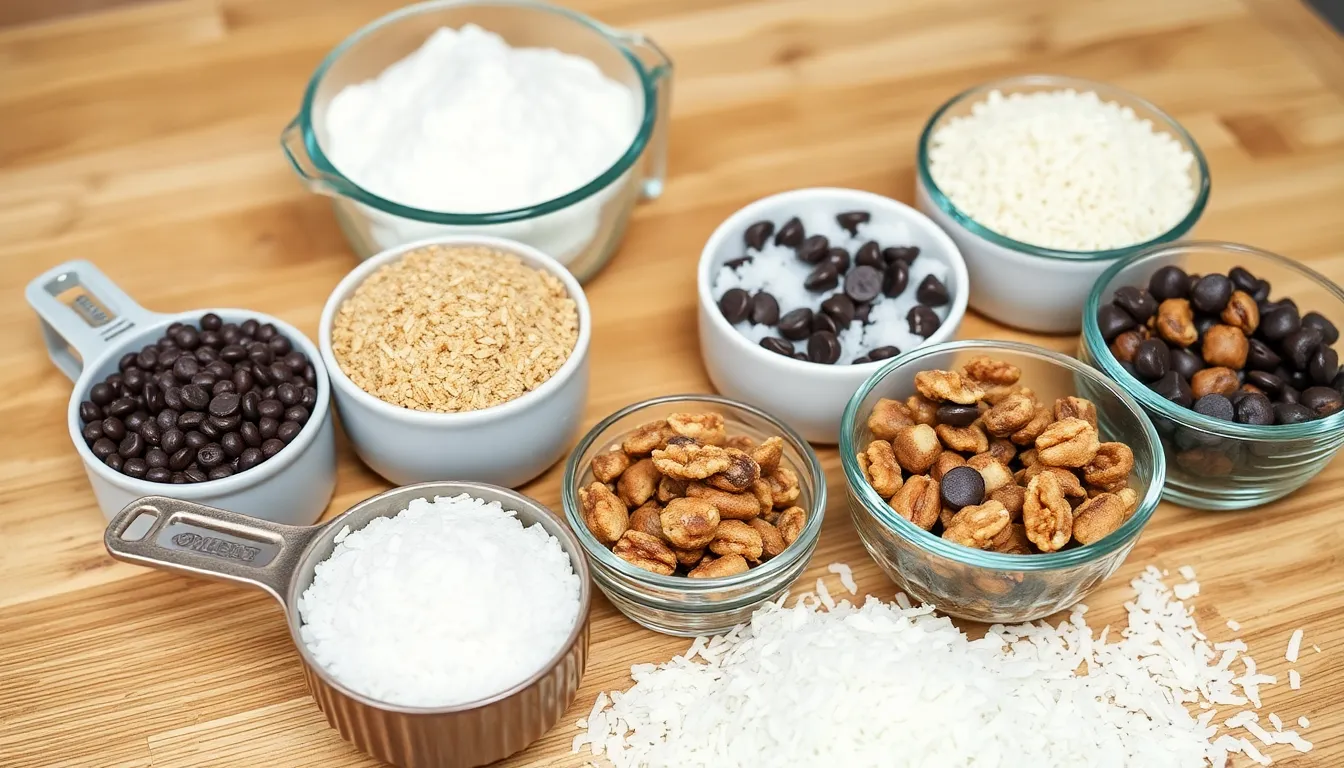
You’ll need precise measurements and quality ingredients to recreate the authentic DoubleTree cookie experience. These carefully selected components work together to achieve the signature texture and rich flavor profile.
Dry Ingredients
- 2¼ cups all-purpose flour
- 1 teaspoon baking soda
- 1 teaspoon salt
- ½ cup rolled oats, finely ground
- ¼ cup granulated sugar
- 1¼ cups packed light brown sugar
Wet Ingredients
- 1 cup unsalted butter, softened to room temperature
- 2 large eggs, room temperature
- 2 teaspoons pure vanilla extract
- 1 tablespoon whole milk
Mix-Ins
- 2 cups premium semi-sweet chocolate chips
- 1½ cups chopped walnuts
- ½ cup sweetened shredded coconut (optional)
Instructions
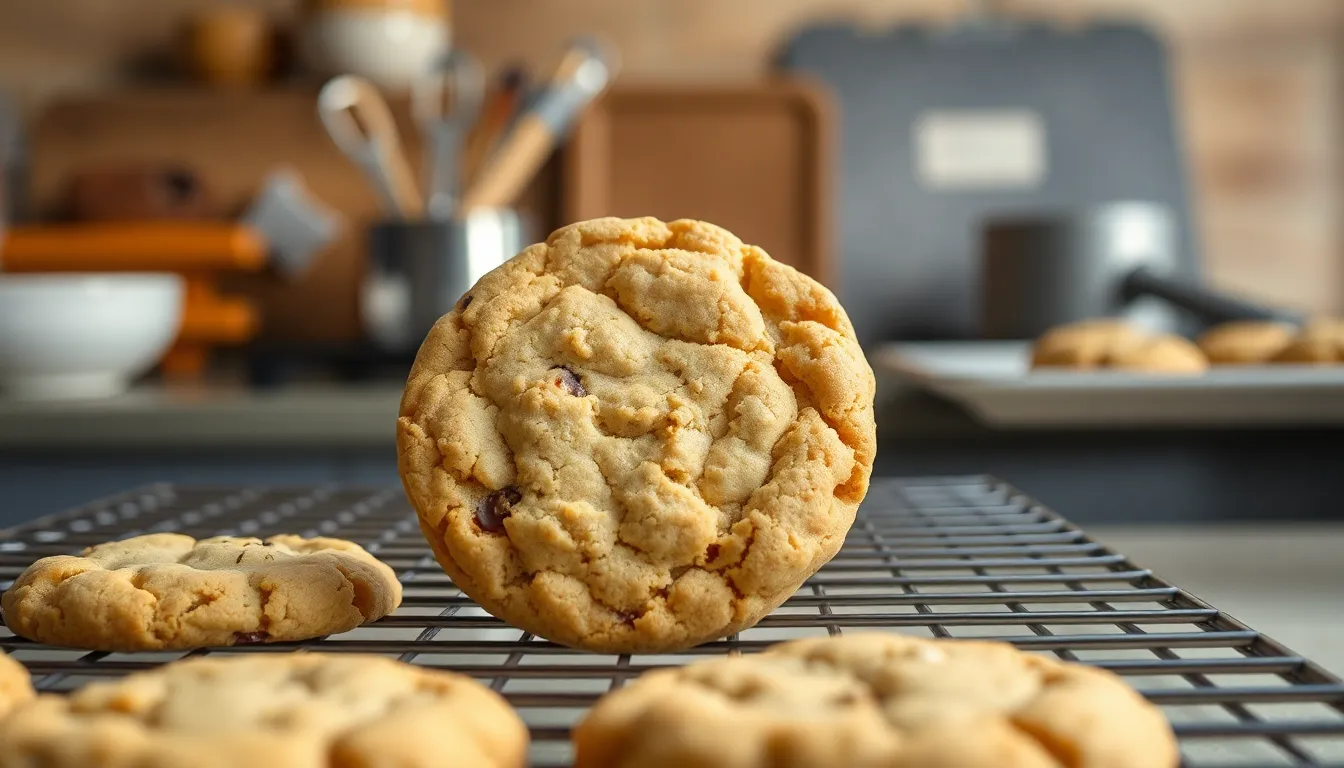
Follow these detailed steps to create authentic DoubleTree cookies with the perfect balance of crispy edges and chewy centers. Each stage requires attention to timing and technique for optimal results.
Prep Work
Preheat your oven to 350°F (175°C) and position racks in the upper and lower thirds. Line two heavy-duty baking sheets with parchment paper to prevent sticking and ensure even browning.
Measure all ingredients using a digital scale for accuracy. Allow your butter to reach room temperature by leaving it out for 45-60 minutes until it yields slightly to pressure. The butter should be soft but not melted or greasy.
Combine flour, baking soda, salt, and ground oats in a medium bowl. Whisk these dry ingredients together thoroughly to distribute the leavening agents evenly throughout the mixture.
Making the Cookie Dough
Cream the softened butter with both brown sugar and granulated sugar in your stand mixer using the paddle attachment. Beat on medium speed for 3-4 minutes until the mixture becomes light and fluffy with a pale color.
Add eggs one at a time, beating well after each addition to ensure proper incorporation. Pour in vanilla extract and milk, mixing until the wet ingredients are completely combined.
Reduce mixer speed to low and gradually add the flour mixture. Mix just until the dry ingredients disappear into the dough to avoid developing tough gluten strands.
Fold in chocolate chips and chopped walnuts using a wooden spoon or rubber spatula. Add coconut flakes if using, distributing all mix-ins evenly throughout the dough without overmixing.
Shaping and Baking
Scoop dough into portions using a large cookie scoop or measuring cup to create 3-ounce portions. Roll each portion gently between your palms to form smooth balls approximately 2 inches in diameter.
Place cookie dough balls on prepared baking sheets, spacing them 3 inches apart to allow for spreading. Press each ball slightly to flatten the bottom while maintaining the rounded top shape.
Bake for 18-22 minutes, rotating pans halfway through baking time for even browning. The cookies are done when edges appear golden brown while centers remain slightly soft and pale.
Remove from oven when edges are set but centers still look slightly underdone. The residual heat will continue cooking the centers to perfect doneness.
Cooling and Storage
Allow cookies to cool on baking sheets for 5 minutes before transferring to wire racks. This brief cooling period prevents breaking while ensuring the cookies maintain their shape.
Transfer cooled cookies to airtight containers once they reach room temperature. Layer cookies between sheets of parchment paper to prevent sticking and maintain texture.
Store at room temperature for up to one week or freeze for up to three months. Warm frozen cookies in a 300°F oven for 2-3 minutes to restore their fresh-baked taste and aroma.
Pro Tips for Perfect DoubleTree Cookies
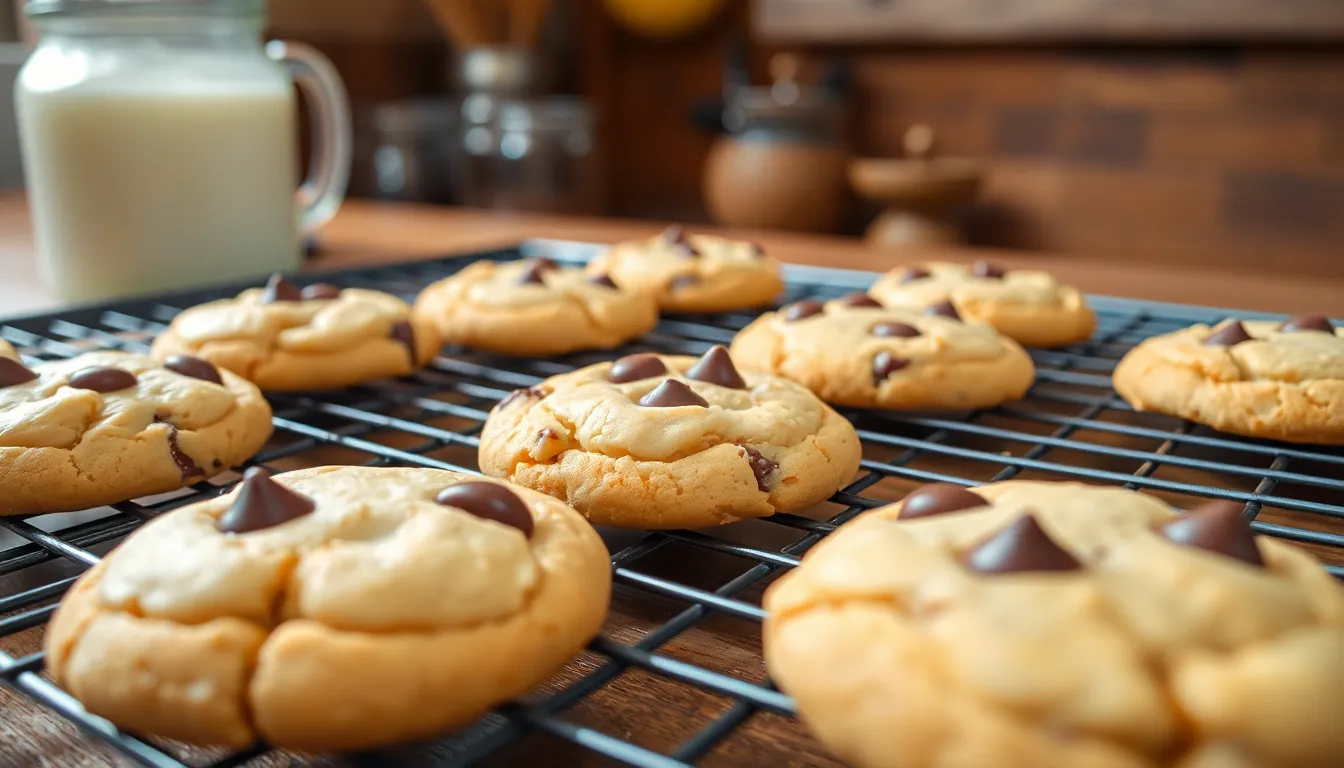
Master the Temperature Balance
Room temperature ingredients create the foundation for exceptional cookies. Butter should yield slightly to gentle pressure but maintain its shape. Eggs straight from the refrigerator will cause the butter to seize and create lumpy dough. Remove eggs from refrigeration 30 minutes before baking to achieve optimal mixing consistency.
Perfect Your Creaming Technique
Beat butter and sugars for exactly 3 minutes at medium speed. Under-creamed mixture produces dense cookies while over-creaming creates thin cookies that spread excessively. The mixture should appear pale yellow and increase in volume by approximately one-third. Stop the mixer occasionally to scrape down bowl sides for even incorporation.
Measure Flour with Precision
Spoon flour into measuring cups rather than scooping directly from the container. Scooping compacts flour and adds up to 30% more than needed. Level each cup with a knife edge for accurate measurement. Too much flour creates dry crumbly cookies while insufficient flour produces flat spreads.
Control Cookie Size for Consistency
Use a #12 cookie scoop or measure 3 tablespoons of dough per cookie. Uniform sizing ensures even baking and prevents some cookies from burning while others remain underdone. Press dough portions gently to compact slightly before placing on baking sheets.
Space Cookies Strategically
Place cookie dough portions 3 inches apart on baking sheets. DoubleTree cookies spread significantly during baking and require adequate space to maintain their signature shape. Crowded cookies merge together and bake unevenly.
Monitor Baking Time Closely
Check cookies at the 10-minute mark rather than waiting for the full recommended time. Oven temperatures vary and cookies continue cooking on hot pans after removal. Look for golden brown edges with centers that appear slightly underdone for perfect texture.
Cool on Pans Initially
Allow cookies to rest on baking sheets for 5 minutes before transferring to cooling racks. This brief cooling period prevents breaking while the cookies firm up. Moving them too quickly creates cracks and uneven shapes.
Store with Care
Place completely cooled cookies in airtight containers with parchment paper between layers. Add a slice of bread to maintain moisture without making cookies soggy. Replace bread every 2 days to prevent staleness. Properly stored cookies maintain their texture for up to one week at room temperature.
Variations and Substitutions
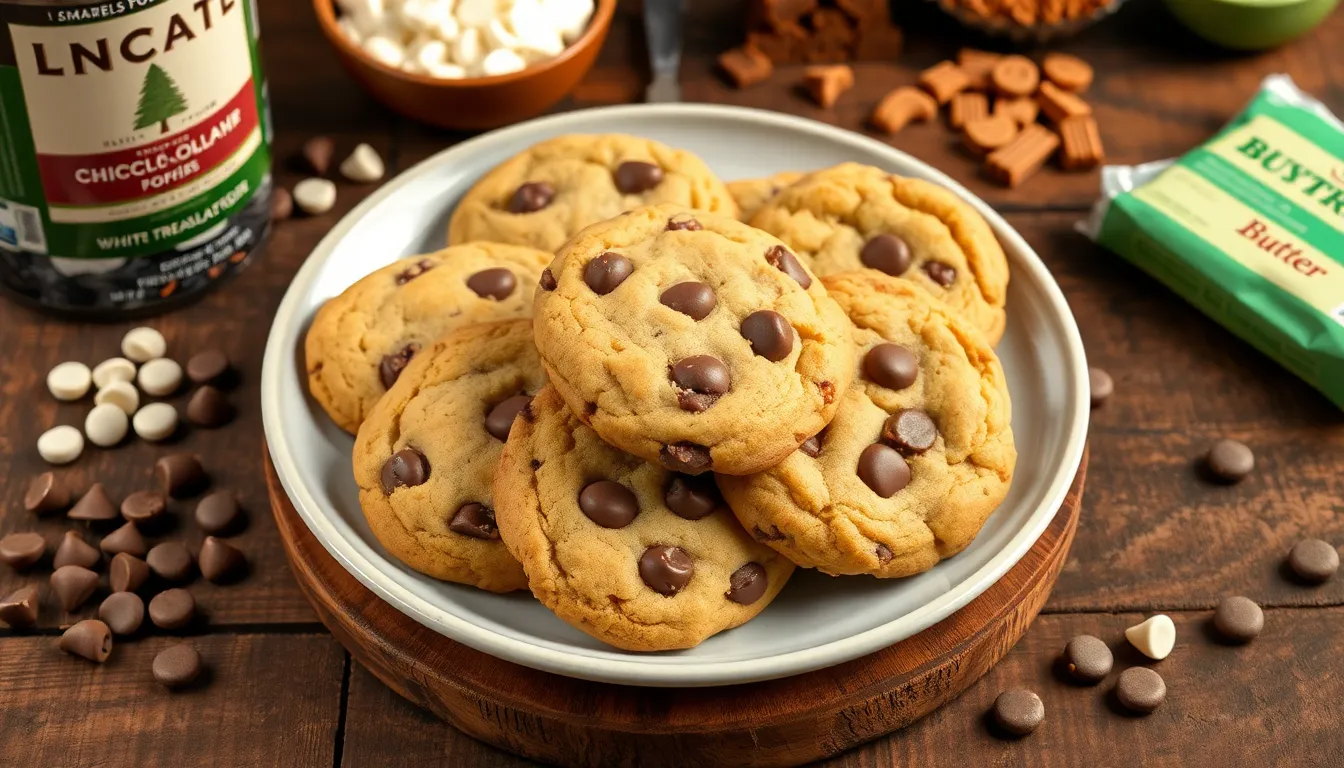
Transform your DoubleTree cookies to match your preferences or dietary needs with these creative adaptations. These modifications maintain the signature texture while offering exciting new flavor profiles.
Chocolate Chip Alternatives
Replace traditional semi-sweet chocolate chips with white chocolate chips for a sweeter and milder flavor profile. The white chocolate creates beautiful contrast against the golden cookie base while maintaining the same melting characteristics during baking.
Dark chocolate chips deliver a more intense cocoa flavor that pairs exceptionally well with the buttery cookie dough. Choose chips with 60-70% cacao content for the perfect balance between richness and sweetness.
Mini chocolate chips distribute more evenly throughout the dough and create consistent chocolate flavor in every bite. Use the same 2-cup measurement but expect slightly different melting patterns during baking.
Chocolate chunks provide irregular shapes and varied textures that mimic artisanal bakery cookies. Cut high-quality chocolate bars into ½-inch pieces for the most authentic appearance and superior melting quality.
Butterscotch chips offer a caramel-like sweetness that complements the vanilla notes in the original recipe. These chips maintain their shape better during baking and add golden color variations to your finished cookies.
Mix different chocolate varieties using 1 cup semi-sweet chips and 1 cup white chocolate chips for a visually appealing two-tone effect. This combination provides flavor complexity while maintaining the original recipe proportions.
Dietary Modifications
Substitute gluten-free flour blend cup-for-cup to accommodate gluten sensitivities without altering the cookie texture. Choose brands containing xanthan gum to ensure proper binding and structure development.
Replace butter with vegan butter sticks that contain similar fat content for plant-based versions. Ensure your vegan butter reaches room temperature before creaming to achieve the proper light and fluffy texture.
Coconut oil works as a dairy-free fat substitute but requires chilling the dough for 30 minutes before shaping. Use refined coconut oil to avoid overwhelming coconut flavor that competes with the vanilla notes.
Sugar-free alternatives like erythritol or stevia blends reduce calories while maintaining sweetness levels. Use 3/4 the amount of sugar substitute compared to regular sugar and expect slightly different browning characteristics.
Egg replacements such as flax eggs or commercial egg substitutes accommodate vegan diets successfully. Mix 2 tablespoons ground flaxseed with 6 tablespoons water and let sit for 5 minutes to replace both eggs.
Reduce sodium content by using unsalted nuts or omitting the salt entirely if you prefer lower-sodium baked goods. The cookies will still develop proper flavor from the vanilla and chocolate components.
Protein powder additions boost nutritional value by replacing ¼ cup flour with vanilla or unflavored protein powder. This modification slightly increases density but maintains the chewy texture profile.
Storage and Make-Ahead Instructions
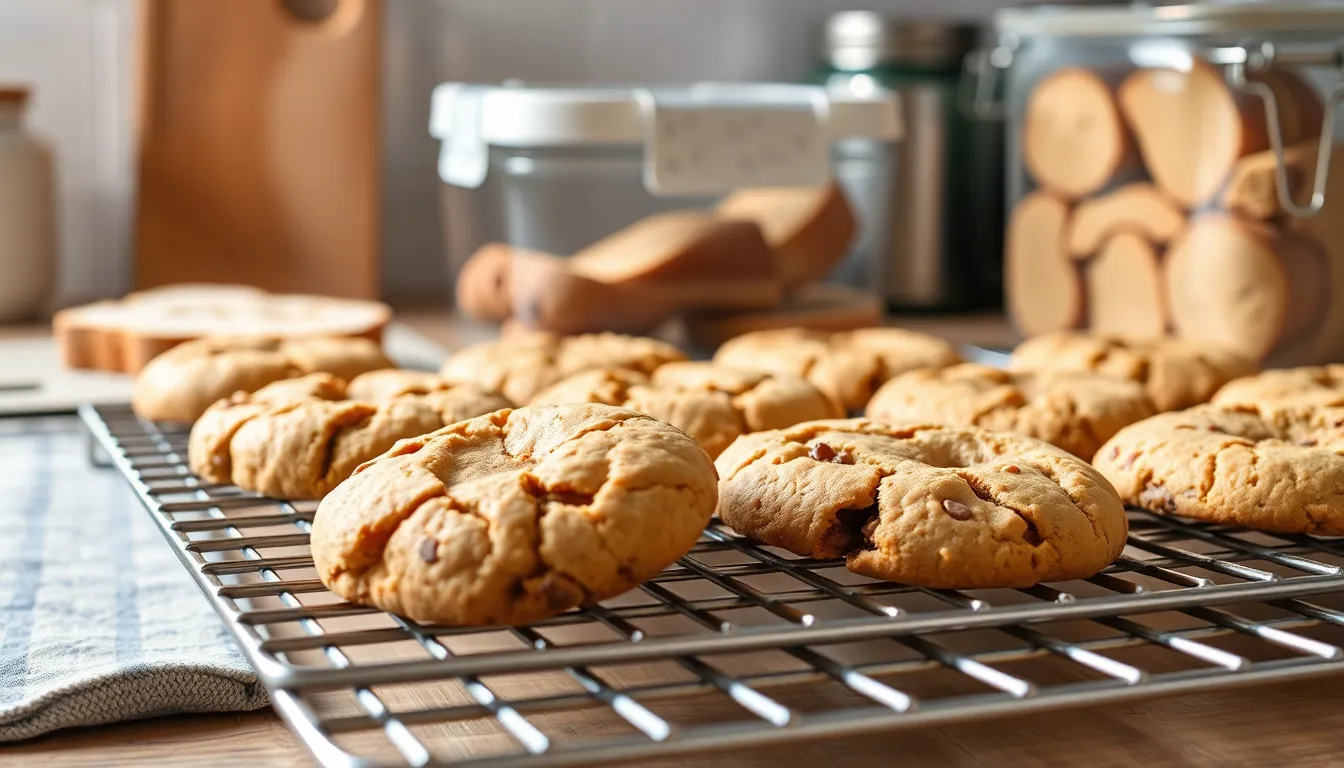
Storing Baked Cookies
Store your DoubleTree cookies in an airtight container at room temperature for up to one week. Layer the cookies between sheets of parchment paper to prevent them from sticking together. Keep the container in a cool dry place away from direct sunlight to maintain optimal freshness.
Place a slice of bread in the storage container to help maintain the cookies’ soft chewy texture. Replace the bread slice every two to three days as it becomes stale. This technique prevents the cookies from becoming overly crispy while preserving their signature texture balance.
Freezing for Long-Term Storage
Freeze baked cookies for up to three months in freezer-safe containers or heavy-duty freezer bags. Wrap individual cookies in plastic wrap before placing them in freezer storage to prevent freezer burn. Label containers with the date to track storage time effectively.
Allow frozen cookies to thaw at room temperature for 30 to 45 minutes before serving. Warm thawed cookies in a 300°F oven for 2 to 3 minutes to restore their fresh-baked taste and aroma. This reheating process recreates the warm cookie experience that makes DoubleTree cookies so memorable.
Make-Ahead Cookie Dough
Prepare cookie dough up to three days in advance and store it covered in the refrigerator. Shape the dough into individual portions and place them on parchment-lined baking sheets before refrigerating. This method allows you to bake fresh cookies whenever desired without starting from scratch.
Freeze shaped cookie dough portions for up to two months in freezer-safe containers. Arrange the dough balls on baking sheets and freeze them solid before transferring to storage containers. Bake frozen dough directly from the freezer by adding 1 to 2 minutes to the original baking time.
Dough Storage Tips
Wrap unbaked cookie dough tightly in plastic wrap and aluminum foil before refrigerating or freezing. Double wrapping prevents the dough from absorbing refrigerator odors and maintains its fresh flavor profile. Mark the wrapped dough with preparation dates for easy identification.
Bring refrigerated dough to room temperature for 10 to 15 minutes before shaping and baking. This brief warming period makes the dough easier to handle and ensures even baking results. Cold dough straight from the refrigerator may spread less during baking creating thicker cookies.
Troubleshooting Common Issues
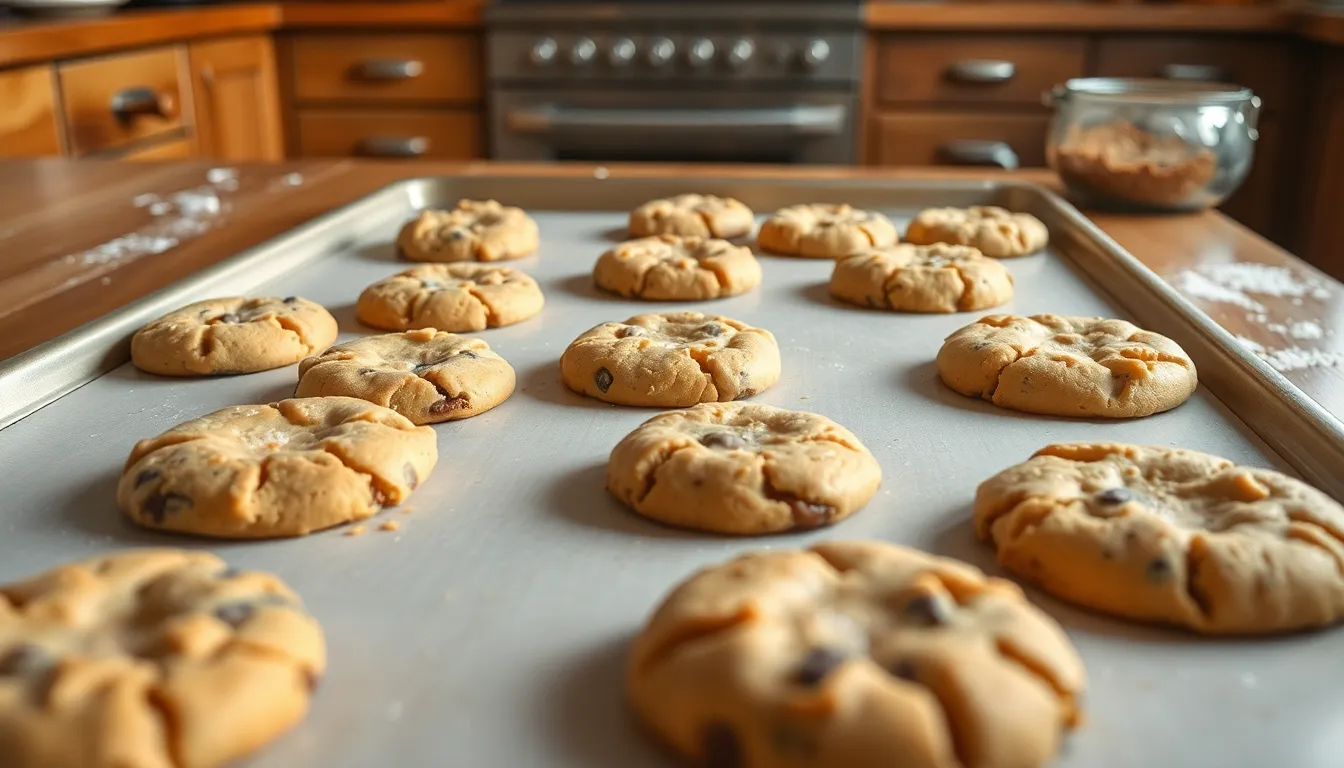
Cookies Spreading Too Much
Your cookies spread excessively when the butter temperature runs too warm or when you skimp on flour measurements. Room temperature butter should feel slightly cool to touch and hold its shape when pressed. Chill your cookie dough for 30 minutes before baking if the butter became too soft during mixing. Add an extra 2-3 tablespoons of flour to your next batch if the spreading continues. Position your baking sheets on the middle rack to ensure even heat distribution.
Cookies Turning Out Too Flat
Flat cookies typically result from insufficient leavening agents or overmixed dough. Check your baking soda expiration date since old leavening loses its effectiveness after six months. Replace it immediately if it fails the fizz test when mixed with vinegar. Measure your flour using the spoon-and-level method rather than scooping directly from the container. Stop mixing once you incorporate the flour to prevent gluten overdevelopment.
Centers Staying Too Soft or Gooey
Underbaked centers occur when oven temperatures run low or baking time falls short. Use an oven thermometer to verify your actual temperature since many ovens run 25-50 degrees cooler than displayed. Extend baking time by 1-2 minutes while watching for golden brown edges. Your cookies should appear slightly underdone when removed since they continue cooking on hot pans.
Edges Burning Before Centers Cook
Uneven baking happens with dark pans that absorb excessive heat or incorrect rack positioning. Switch to light-colored aluminum pans that reflect heat evenly. Move your baking rack to the center position if using the top or bottom slots. Reduce oven temperature by 25 degrees and extend baking time by 2-3 minutes for gentler cooking.
Cookies Lacking Flavor Depth
Bland cookies stem from using expired vanilla extract or skipping the salt component. Replace vanilla extract after two years since it loses potency over time. Double-check that you added the full teaspoon of salt as it enhances all other flavors. Toast your chopped walnuts for 5-8 minutes before mixing to intensify their nutty taste.
Dough Appears Too Dry or Crumbly
Dry dough results from excessive flour or insufficient fat content. Add milk one teaspoon at a time until the dough holds together without cracking. Ensure your butter measures exactly one cup when softened properly. Humidity levels affect flour absorption so adjust liquid ingredients accordingly on particularly dry days.
Chocolate Chips Sinking to Bottom
Heavy mix-ins sink when the dough lacks structure or when chips are too large. Toss chocolate chips and nuts with a tablespoon of flour before folding into dough. Use standard-sized chips rather than jumbo varieties that weigh down the batter. Chill shaped cookies for 15 minutes before baking to firm the dough structure.
Conclusion
You now have everything you need to bring the magic of DoubleTree’s legendary cookies into your own kitchen. With the authentic recipe proper techniques and insider tips you’ll create cookies that rival the hotel’s famous treats.
Whether you’re hosting guests or simply treating yourself these warm chocolate chip cookies will transform any moment into a special occasion. The combination of crispy edges chewy centers and premium ingredients makes every bite worth the effort.
Don’t hesitate to experiment with the variations and make-ahead options to suit your schedule and preferences. Your homemade DoubleTree cookies will soon become the highlight of any gathering creating memories as sweet as the cookies themselves.

